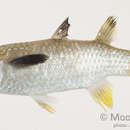Diagnostic Description
(
Inglês
)
fornecido por Fishbase
This species is distinguished by the following characters: robust body; usually with 16 pectoral-fin rays; 25-29 longitudinal scales; 16 circumpeduncular scales; weakly ctenoid scales; adults with longer snout than eye diameter, shorter in juvenile; poorly developed adipose eyelid, forming narrow rim around eye; weak notch on anteroventral edge of preorbital; truncate caudal fin. Colour olive-brown dorsally, flanks and belly silvery to whitish; about 6 brownish stripes on flank formed by longitudinal marks on scales; fins yellowish white with dusky margins except caudal fin yellow and pectoral black dorsally and yellow ventrally (completely black in young) No axillary scale visible in the pectoral fins (Ref. 9812, 90102).
- licença
- cc-by-nc
- direitos autorais
- FishBase
Migration
(
Inglês
)
fornecido por Fishbase
Catadromous. Migrating from freshwater to the sea to spawn, e.g., European eels. Subdivision of diadromous. Migrations should be cyclical and predictable and cover more than 100 km.
- licença
- cc-by-nc
- direitos autorais
- FishBase
- Recorder
- Estelita Emily Capuli
Morphology
(
Inglês
)
fornecido por Fishbase
Dorsal spines (total): 4; Dorsal soft rays (total): 9 - 10; Analspines: 3; Analsoft rays: 7 - 9
- licença
- cc-by-nc
- direitos autorais
- FishBase
Trophic Strategy
(
Inglês
)
fornecido por Fishbase
Inhabits coastal waters (Ref. 9137) and coral reefs (Ref. 58534). Usually within tidal influence, but may enter fresh water, ascending 10 km into rivers (Ref. 40488). Form large schools, frequently in mangrove areas (Ref. 2334). Juveniles may be found in rice fields and mangroves (Ref. 9812).
- licença
- cc-by-nc
- direitos autorais
- FishBase
Biology
(
Inglês
)
fornecido por Fishbase
Inhabit lagoons, reef flats, estuaries, and coastal creeks, in shallow coastal areas and protected sandy shores (Ref. 40488). Usually within tidal influence, but may enter fresh water, ascending 10 km into rivers (Ref. 40488). Form large schools, frequently in mangrove areas (Ref. 2334). Juveniles may be found in rice fields and mangroves and may be used as bait fish (Ref. 9812). Oviparous, eggs are pelagic and non-adhesive (Ref. 205). Feeds on phytoplankton, small algae and detritus organisms (Ref. 89972). Caught in cast nets, stakenets, beach seines, and gill nets; marketed fresh and salted; boiled (Thailand), canned or frozen (Australia). Roe also marketed salted and juveniles used as bait fish (Ref. 9812)..
- licença
- cc-by-nc
- direitos autorais
- FishBase
- Recorder
- Estelita Emily Capuli
Importance
(
Inglês
)
fornecido por Fishbase
fisheries: commercial; aquaculture: commercial; aquarium: commercial; bait: occasionally
- licença
- cc-by-nc
- direitos autorais
- FishBase
- Recorder
- Estelita Emily Capuli

